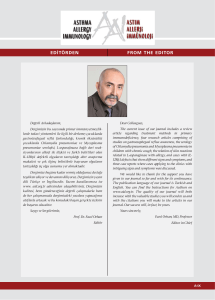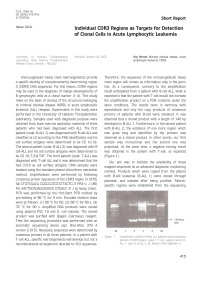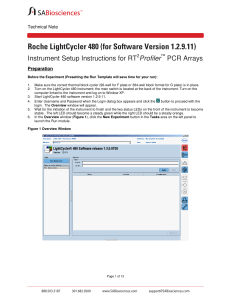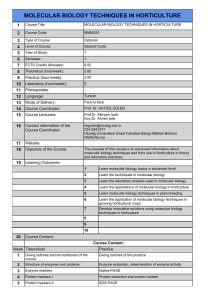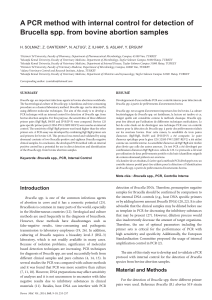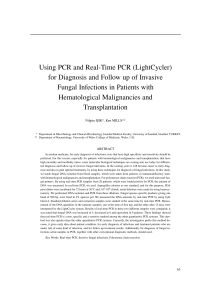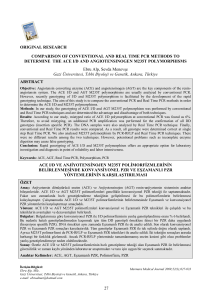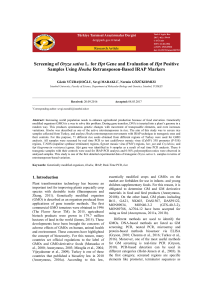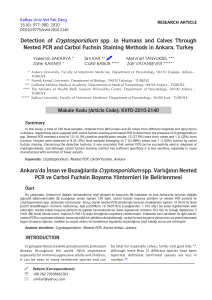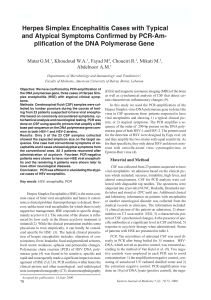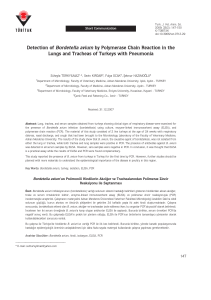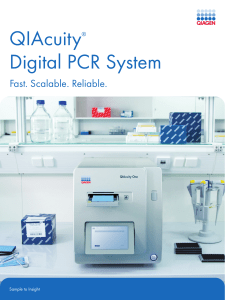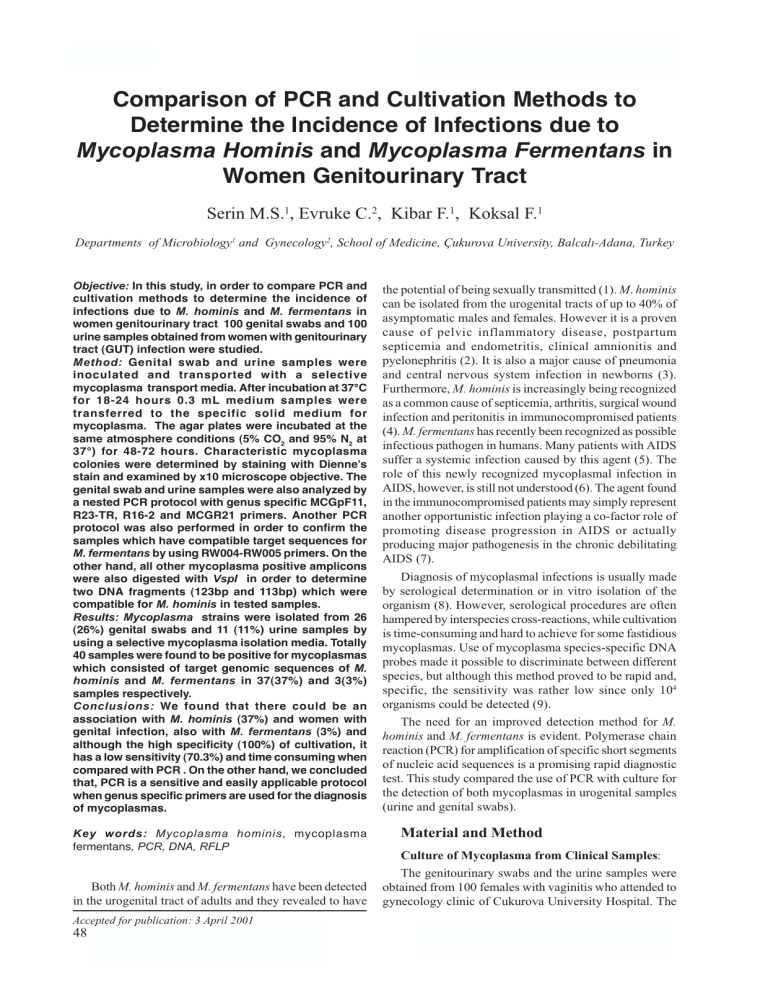
Serin et al.
Comparison of PCR and Cultivation Methods to
Determine the Incidence of Infections due to
Mycoplasma Hominis and Mycoplasma Fermentans in
Women Genitourinary Tract
Serin M.S.1, Evruke C.2, Kibar F.1, Koksal F.1
Departments of Microbiology1 and Gynecology2, School of Medicine, Çukurova University, Balcalý-Adana, Turkey
Objective: In this study, in order to compare PCR and
cultivation methods to determine the incidence of
infections due to M. hominis and M. fermentans in
women genitourinary tract 100 genital swabs and 100
urine samples obtained from women with genitourinary
tract (GUT) infection were studied.
Method: Genital swab and urine samples were
inoculated and transported with a selective
mycoplasma transport media. After incubation at 37°C
for 18-24 hours 0.3 mL medium samples were
transferred to the specific solid medium for
mycoplasma. The agar plates were incubated at the
same atmosphere conditions (5% CO2 and 95% N2 at
37°) for 48-72 hours. Characteristic mycoplasma
colonies were determined by staining with Dienne’s
stain and examined by x10 microscope objective. The
genital swab and urine samples were also analyzed by
a nested PCR protocol with genus specific MCGpF11,
R23-TR, R16-2 and MCGR21 primers. Another PCR
protocol was also performed in order to confirm the
samples which have compatible target sequences for
M. fermentans by using RW004-RW005 primers. On the
other hand, all other mycoplasma positive amplicons
were also digested with VspI in order to determine
two DNA fragments (123bp and 113bp) which were
compatible for M. hominis in tested samples.
Results: Mycoplasma strains were isolated from 26
(26%) genital swabs and 11 (11%) urine samples by
using a selective mycoplasma isolation media. Totally
40 samples were found to be positive for mycoplasmas
which consisted of target genomic sequences of M.
hominis and M. fermentans in 37(37%) and 3(3%)
samples respectively.
Conclusions: We found that there could be an
association with M. hominis (37%) and women with
genital infection, also with M. fermentans (3%) and
although the high specificity (100%) of cultivation, it
has a low sensitivity (70.3%) and time consuming when
compared with PCR . On the other hand, we concluded
that, PCR is a sensitive and easily applicable protocol
when genus specific primers are used for the diagnosis
of mycoplasmas.
Key words: Mycoplasma hominis, mycoplasma
fermentans, PCR, DNA, RFLP
Both M. hominis and M. fermentans have been detected
in the urogenital tract of adults and they revealed to have
Accepted for publication: 3 April 2001
48
the potential of being sexually transmitted (1). M. hominis
can be isolated from the urogenital tracts of up to 40% of
asymptomatic males and females. However it is a proven
cause of pelvic inflammatory disease, postpartum
septicemia and endometritis, clinical amnionitis and
pyelonephritis (2). It is also a major cause of pneumonia
and central nervous system infection in newborns (3).
Furthermore, M. hominis is increasingly being recognized
as a common cause of septicemia, arthritis, surgical wound
infection and peritonitis in immunocompromised patients
(4). M. fermentans has recently been recognized as possible
infectious pathogen in humans. Many patients with AIDS
suffer a systemic infection caused by this agent (5). The
role of this newly recognized mycoplasmal infection in
AIDS, however, is still not understood (6). The agent found
in the immunocompromised patients may simply represent
another opportunistic infection playing a co-factor role of
promoting disease progression in AIDS or actually
producing major pathogenesis in the chronic debilitating
AIDS (7).
Diagnosis of mycoplasmal infections is usually made
by serological determination or in vitro isolation of the
organism (8). However, serological procedures are often
hampered by interspecies cross-reactions, while cultivation
is time-consuming and hard to achieve for some fastidious
mycoplasmas. Use of mycoplasma species-specific DNA
probes made it possible to discriminate between different
species, but although this method proved to be rapid and,
specific, the sensitivity was rather low since only 104
organisms could be detected (9).
The need for an improved detection method for M.
hominis and M. fermentans is evident. Polymerase chain
reaction (PCR) for amplification of specific short segments
of nucleic acid sequences is a promising rapid diagnostic
test. This study compared the use of PCR with culture for
the detection of both mycoplasmas in urogenital samples
(urine and genital swabs).
Material and Method
Culture of Mycoplasma from Clinical Samples:
The genitourinary swabs and the urine samples were
obtained from 100 females with vaginitis who attended to
gynecology clinic of Cukurova University Hospital. The
Eastern Journal of Medicine 6 (2): 48-52, 2001
Comparison of PCR and cultivation methods ....
Table I. Sequences of oligonucleotides in the gene spacer region in 16S-23S rRNA of mycoplasmas (11).
Primers
Oligonucleotide sequences
MCGpF11
R23-1R
R16-2
MCGpR21
5’-ACA CCA TGG GAG (C/G) TGG TAA T-3’
5’-CTC CTA GTG CCA AG (C/G) CAT (C/T) C-3’
5’-GTG (C/G) GG (A/C) TGG ATC ACC TCC T-3’
5’-GCA TCC ACC A(A/T) A(A/T) AC(C/T) CTT-3’
Table II. Second step PCR products and restriction length polymorphisms after digestion by several restriction
endonuclease (11).
Mycoplasma
species
M .pirum
M. fermentans
M orale
M. arginini
M. hominis
M. genitalium
M. hyorhinis
M .pneumoniae
M. salivarium
A .laidlawii
2nd round
PCR
product
323bp
365
290
236
236
252
315
280
269
430,223
VspI
HindIII
HincII
ClaI
169, 154
270, 95
151, 139
134, 102
123, 113
190, 62
-
285, 38
241, 124
-
196, 127
-
253, 62
-
PvuII
-
HaeIII
221, 69
-
Table III. Sequences of oligonucleotides in the IS-Like segment of Mycoplasma fermentans (7)
Primers
RW004
RW005
swabs were transported to the laboratory in mycoplasma
transport medium containing inactivated horse serum
(20%), 10 mL yeast extract (25%), 144 mL brain-heart
infusion broth, 1 mL tallium acetate (1/80), 5 mL phenol
red (0.2%), penicillin (1000U/mL) and 5 mL arginin
(20%). The urine samples were collected and transported
in sterilized tubes. The urine samples were centrifuged at
3000xg for 10 minutes and the pellet was transferred to
the transport medium. All inoculated transport media
(swabs and urine) were incubated in an atmosphere
containing 5% CO2 and 95% N2 at 37°C for 18-24 hours.
The color changes were taken as the criteria of growth.
0.3 mL of medium sample was transferred from color
changed medium to the specific solid medium for
mycoplasma containing brain-heart infusion broth, noble
agar, inactivated horse serum (20%), 10 mL yeast extract
(25%), penicillin (1000U/mL), 1mL phenol red (0.1%), 2
mL thallium acetate (1/80) and 10 mL arginin (20%). The
agar plates were incubated at the same atmosphere
condition (5% CO2 and 95% N2 at 37°C) for 48-72 hours.
Characteristic mycoplasma colonies were determined by
staining with Diennes stain and examined by a
microscope. These colonies were characterised by their
Eastern Journal of Medicine 6 (2): 48-52, 2001
Oligonucleotide sequences
5’-GGA CTA TTG TCT AAA CAA TTT CCC-3’
5’-GGT TAT TCG ATT TCT AAA TCG CCT-3’
haemolytic and glucose fermentation properties. We used
horse blood instead of sheep or guinea pig erytrocytes for
haemolytic activity. As known, recently M. pneumoniae
has been isolated from genitourinary system (10). We
cultured reference M. pneumoniae ATCC 15377 as control
for haemolytic activity. This strain was grown better in
horse blood containing mycoplasma medium than sheep
erythrocyte containing mycoplasma medium with greenish
β-haemolytic zones. None of our clinical isolates
fermented glucose and showed haemolytic activity while
reference M. pneumoniae ATCC 15377 made haemolysis
on horse blood containing mycoplasma medium.
Therefore, we partly characterised that those are not M.
fermentans but highly probably M. hominis. We confirmed
those findings by PCR and PCR-RFLP.
Sample Preparation for PCR
The swab samples were inoculated in the mycoplasma
transport medium which is not containing any stain and
antibiotics. The urine samples were centrifuged and the
pellet was transferred to the same medium. The media were
stored at 40°C until examining by PCR. When examined,
they were thawed and centrifuged at 2000 G for 10
49
Serin et al.
Figure 2. Lanes show resulted restricted products after
digest ion by VspI which are 123bp and 13bp.
Figure 1. Lane 1 and Lane 2 show 365bp and 236bp PCR
products which are genomic sequences of M.fermentas
and M.hominis respectively.
Figure 3. Lane 1, 3 and 4 show 206bp PCR products which
are compatible for M.fermentans
minutes. The pellet was transferred to a microfuge tube
and the same volume of sterilised distilled water was added
to the pellet. This mixture was incubated at 37°C for 20
minutes and the final mixture was used as DNA sample
for PCR.
PCR Amplification
Oligonucleotide primers were chosen from the
published nucleotide sequences of conserved intergenic
spacer region in 16S-23S rRNA of mycoplasmas (11). We
have used a protocol reported for the diagnosis of
mycoplasmas in cell cultures by Harasawa et al (11) and
modified for diagnosis of mycoplasmas in clinical samples
(11). This is a nested PCR protocol with the
oligonucleotides MCGpF11, R23-1R and internal R16-2,
MCGpR21 using (Table I). The restriction length
50
polymorphisms of the end product of second step have a
significant diagnostic value (Table II).
The restriction length polymorphisms of the end
product of second step have a significant diagnostic value
(Table II).
Amplification of samples (10mL) was performed in a
final volume of 50mL. The reaction mixture consisted of
2.5 units of Taq DNA polymerase (Stratagene 600131);
200mM each of dATP, dCTP, dTTP and dGTP; 100pM
primers MCGpF11 and r23-1R and 1x assay buffer (50mM
KCI; 10mM Tris-HCI [pH 8.8]; 1.5 mM MgCI2; 0.01%
gelatine) supplied with the enzyme by the manufacturer.
Two drops of light mineral oil were added to the each tube
and the amplification reaction was performed after preheating at 94°C for 30 seconds, annealing at 72°C for 2
minutes and elongation at 72°C for 2 minutes was
performed. After the first step of amplification, 1mL of
amplificated product was transferred to a new reaction tube
and amplified in the same reaction mixture as used in the
first amplification step.
Analysis of Amplified Samples
The products of PCR were analyzed by 2% agarose
gel electrophoresis and ethidium bromide staining.
Samples containing a band of the expected size for M.
hominis (236bp) subjected to digestion with a restriction
endonuclease enzyme. Amplified DNA from M. hominis
was digested with VspI in order to confirm. Other samples
containing expected size of DNA band for M. fermentans
(365 bp) were subjected to amplification with primers
RW004 and RW005 (Table III) which are very sensitive
and spesific for IS-Like segment of M. fermentans reported
by Wang et al (7).
The second PCR was performed for confirmation
of the first PCR products consisting of expected size bands
samples. For this reason, 10mL of sample DNA was
amplified in a final volume of 50mL reaction mixture
consisting of 2.5 units of taq DNA polymerase (Stratagene
Eastern Journal of Medicine 6 (2): 48-52, 2001
Comparison of PCR and cultivation methods ....
600131), 200mM each dNTP (Stratagene 200415), 0.5 mM
primers RW004 and RW005 and 1 x assay buffer (50mM
KCI, 10mM Tris-HCI [pH8.8];1.5 mM MgCI2 ; 0.001%
gelatine). After addition of two drops of light mineral oil
and pre-heating at 94°C for 2 minutes, PCR was performed
totally 45 cycles of denaturation at 94°C for 35 seconds,
annealing at 55°C for 45 seconds and elongation at 72°C
for 50 seconds for incubation. The analysis of the products
was also performed by 2% agarose gel electrophoresis and
ethidium bromide staining.
Results
M. hominis strains were isolated from 26 (26%) genital
swabs and 11 (11%) urine samples by using specific
mycoplasma isolation media. M. fermentans strains were
isolated from neither genital swabs nor urine samples by
cultivation. But we have also found 40 samples positive
for mycoplasmas which consisted of target genomic
sequences (236bp and 365bp) of M. hominis and M.
fermentans in 37 (37%) and 3 (3%) samples respectively
by PCR which used genus specific MCGpF11, R23-TR,
R16-2 and MCGR21 primers (Figure 1).
Amplified M. hominis DNA (236bp) from 37 samples
were digested by VspI and confirmed with the presence of
resulted 123bp and 113bp compatible for M. hominis in
tested samples (Figure 2). Another PCR protocol was also
performed for M. fermentans compatible sequences which
is 206bp consisting samples by using RW004 and RW005
primers, and 3 samples were found positive by this second
PCR (Figure 3).
In conclusion, a possible relation was found between
colonisation of M. hominis (37%) or M. fermentans (3%)
and women with genital infection. Additionally, we
determined that despite the high specifity (100%) of
cultivation, it has a low sensitivity (70.3%) and is time
consuming when compared with PCR.
Discussion
The role of mycoplasmas in the genital and extragenital
systems is speculative and depends on epidemiologic data.
Experimental infection and colonisation attempts in the
genital region were unsuccessful by mycoplasmas. Clinical
results showed that mycoplasma incidence is raised in the
presence of an anaerobic primer pathogen bacterium such
as T. vaginalis, C. trachomatis or N. gonorrhoea. These
findings were frequently obtained from studies which used
microbiologic cultivation methods. According to these
findings mycoplasmas are either non-pathogen
microorganisms or satellite microorganisms which are
growing in the stress environment created by primary
pathogen. On the other hand, it could be thought that these
microorganisms colonise numerously in a sexually active
woman but could not be detected due to less sensitivity of
microbiological cultivation methods. However after an
infection, their colonisation ratio raises up and can be
detected by conventional cultivation methods. Out of this
thesis, if they are really pathogen and can lead to a chronic
Eastern Journal of Medicine 6 (2): 48-52, 2001
infection, it is known that pathological damage would lead
to genital cell metaplasia occurred by cytokines secreted
by inflammatory cells.
In order to answer all these questions, a sensitive,
specific, fast, cheap and easily applicable, diagnostic
method is necessary. PCR is recommended for
mycoplasma infections like many other infections as an
extremely sensitive and spesific method. In addition to
PCR, Harasawa (11) has reported that PCR-RFLP is fast,
specific, and sensitive method for the diagnosis of human
originated mycoplasma.
In this study, we used Harasawas (11) PCR-RFLP and
conventional cultivation methods in order to detect the
incidence and species of mycoplasma in patients with
genitourinary tract infection. Another PCR protocol was
also performed which is reported by Wang et all (7) in
order to confirm the samples which have compatible target
sequences for M. fermentans by using of RW004-RW005
primers. We concluded, that PCR method is a sensitive
and easily applicable protocol when genus specific primers,
VspI and Wangs primers, is used for the diagnosis of
genital mycoplasmas.
References
1. Blanchard A, Hamrick W, Duffy L, Baldus K, Cassel GH:
Use of the Polymerase Chain Reaction for Detection of
Mycoplasma fermentans and Mycoplasma genitalium in the
Urogenital Tract and Amniotic Fluid. Clin Infec Dis(17 suppl)
1: 272-279, 1993.
2. Cassell GH, Waites KB: Venereal mycoplasmal infections:
In Infectious diseases, a modern treatise of infectious
processes. Eds: P.D. Hoeprich, and M.C. Jordan, J.B.
Lippincott Company, Philadelphia 1989, pp: 632-638.
3. Cassell GH, Waites KB, Crouse DT: Prenatal mycoplasmal
infections. Clin Prenatal 18: 241-262, 1991.
4. Blanchard A, Yanez A, Dybvig K, Watson HL, Griffiths G,
Cassel GH: Evaluation of Intraspecies Genetic Variation
within the 16S rRNA Gene of M.hominis and detection by
Polymerase Chain Reaction. J Clin Microbiol 31: 1358-1361,
1993.
5. Lo SC, Shih WK, Yang NY, Ou CY, Wang YH: Anovel virus
like infectious agent in patients with AIDS. Am J Trop
Med Hyg 40: 213-226, 1989.
6. Lo SC, Tsai S, Benish JR, Shih K, Wear DJ, Wang DM:
Enhencament of HIV-1 cytocidal effects in CD4+
lymphocytes by the AIDS-associated mycoplasma. Science
251: 1074-1076, 1991.
7. Wang RYH, Hu WS, Dawson MS, Shih JWK, Lo SC:
Selective Detection of Mycoplasma fermentans by PCR and
by using a nucleotide sequence within the insertion sequencelike element. J Clin Microbiol 30: 245-48, 1992.
8. Clyde WA, Kenny GE, Schachter J: Cumitech 19 Laboratory
diagnosis of Chlamydial and mycoplasmal infections, Am
Society Microbiol, 1984.
9. Kuppeveld FJM, Logt JTM, Angulo AF, et al: Genus and
species-specific identification of mycoplasmas by 16S rRNA
amplification. App Env Microbiol, 59: 2606-2615, 1992.
51
Serin et al.
10. Sharma S, Brousseau R, Kasatiya S: Detection and
confirmation of Mycoplasma pneumoniae in urogenital
specimens by PCR. J Clin Microbiol 36: 277-280, 1998.
11. Harasawa R, Mizusawa H, Nozawa K, Nakagawa T, Asada
K, Kato I: Detection and tentative identification of dominant
Mycoplasma species in cell cultures by restriction analysis
of the 16S-23S rRNA intergenic spacer regions. Res
Microbiol 144: 489-493, 1993.
Correspondence:
Dr. Mehmet S. SERIN
Çukurova Üniversitesi Týp Fakültesi,
Gastroenteroloji Bilim dalý, Moleküler,
Biyoloji Laboratuarý.
Balcalý-Adana/ TÜRKÝYE
52
Eastern Journal of Medicine 6 (2): 48-52, 2001

